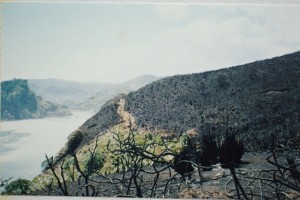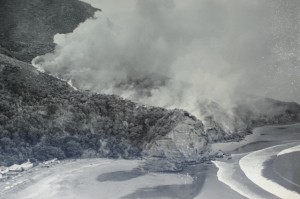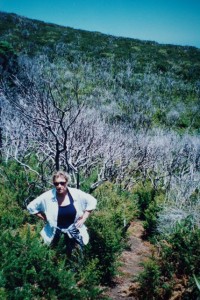Bush regeneration project after fire
Since 1994 a major bush regeneration project has been occurring on my family property, the Pearce property. A disastrous fire in February 1994 destroyed seven hectares of bush. The fire spread up from ARC land on the Tasman Lookout Track onto the Byers and Pearce land. It took too long for the helicopters to come in and the land was not accessible by road. It took hours for the fire to come under control and in that time many acres were burned.
The land had been farmed until about the 1940s, and the regeneration has been a stop-start process because of fires. The bush that was destroyed was mainly kanuka and manuka, with nikau, ponga and other forest species starting to appear underneath it.
In October 1998 a second fire devastated part of the same area.

Blackened hillside after the 1994 fire, the track is through the Waitakere Ranges Regional Parkland that runs along the cliff edge
Since 1994 Sandra Coney and Peter Hosking have been working on the Pearce land to get the land back into bush as quickly as possible. The site is steep, prone to being battered by strong winds and there is no water source. The project was given a start by the Piha Environmental Group which planted pohutukawas and scattered manuka seed.
Since then, Coney and Hosking have been battling the sea of gorse that sprung up in the wake of the fires. Fire causes gorse seeds that have lain in the soil for decades to spring into life, and the thick growth, rather than sheltering natives that are coming away, smothers and outgrows them. Much of the work has involved making space for the manuka, flax, coprosmas and mahoes to flourish.
The fastest growing gorse – in sheltered locations – is tackled first. Spraying pampas is another important task as this imported weed flourishes at Piha.
To ensure that plants are genetically acclimatised to Piha, seed is collected from bush elsewhere on the property or around Piha, grown into plants and then returned to the site. Other plants have been purchased from local people. Many hundreds of karos, pohutukawas and coprosmas have been planted.
This is a long term project. Because of its size, the whole area cannot be taken on at once. The hope is that as areas of bush are re-established, seeds from these blocks will be spread by birds and wind throughout the site. Already bush in the gully above the Green Rock is well underway, as are other areas




